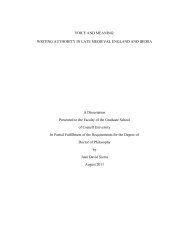CARPET WEAVERS AND WEAVING IN THE ... - Cornell University
CARPET WEAVERS AND WEAVING IN THE ... - Cornell University
CARPET WEAVERS AND WEAVING IN THE ... - Cornell University
You also want an ePaper? Increase the reach of your titles
YUMPU automatically turns print PDFs into web optimized ePapers that Google loves.
objects want goods with “traditions,” with “histories” (Stephen 1991, Nash 1993,<br />
Graburn 1999). Authenticity “has to do not only with genuineness and the reliability<br />
of face value, but with the interpretation of genuineness and our desire for it” (Spooner<br />
1986, 200). Those who talk of authenticity are “attempting to demonstrate, to<br />
themselves if no one else, a superior knowledge and power of discrimination”<br />
(Graburn 1999, 352). Thus, these goods can be purchased for use value, but also (in<br />
the case of high-quality items) for future resale – “the promise that oriental carpets,<br />
though bought for use, are a ‘good investment’” (Kopytoff 1986, 75).<br />
Intermediaries transmit “the important information about the status of the<br />
artifact as commodity or treasure” (Graburn 1999, 349). In the export market, “trade<br />
diasporas” facilitate world trade by negotiating differing value and exchange systems<br />
across cultures (Kopytoff 1986, 88). In the domestic or import market these<br />
facilitators are often community members or the artisans themselves, though the<br />
government is also involved. Nash cites Geshekter (1978) in saying that tourism<br />
works within the international capitalist system in order to sell a country-as-product<br />
(1993, 13). Conservation of objects (crafts, or, in Orbasli’s research, buildings or<br />
historic neighborhoods in Bergama, Turkey) does not conserve culture – “it is<br />
improvements to their immediate needs and ‘quality of life’ that will be a measure of<br />
development” (Orbasli 1994, 4).<br />
In summary, while incorporation into the world market has broadened the<br />
consumer base for craft items, it can also alter the design and significance of these<br />
items, changing production for the community to production for export. Production<br />
for export often caters to an external conception of authenticity, privileging foreign<br />
aesthetics over local forms and traditions. Items can also be bought as investments,<br />
though this is true mainly of high quality items with an elite clientele. Information<br />
14

















